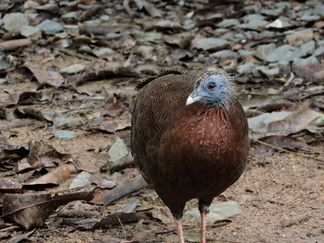Taman Negara (National Park), Pahang, Peninsular Malaysia.
- Simply Stunning Birds

- Jul 17, 2021
- 4 min read
All images are Copyrighted © Simply Stunning Birds. All Rights Reserved.
All bird artworks are Copyrighted © Birds of the World, Cornell Lab of Ornithology.
Get directions to Western Entrance (Google Maps)
Get directions to Main Entrance (Google Maps)
View species list (Avibase)
Trails (tamannegara.asia)
Accommodation (Agoda)
About Taman Negara National Park
Taman Negara National Park is a vast wilderness area that encompasses a 130 million year old tropical rainforest. Established in 1938, the park has a total area of 4,343 km² and it is one of the world's oldest deciduous rainforests. Kuala Tahan, the main entry point, is a base for the nearby canopy walkway, river trips and treks through the jungle to the top of Mt. Tahan. The park is home to over 150 species of mammals, including the Malayan Tiger, the Clouded Leopard and various primate species, and is also home to the world's largest flower, the Rafflesia, which can grow up to 91cm. 491 bird species have been recorded in the park, of which 6 are introduced. From the Western Entrance near Merapoh, 310 species have been recorded, and 394 species have been recorded from the Main Entrance at Kuala Tahan.
White-rumped Shama Rusty-breasted Cuckoo Red-throated Barbet
Target Sites
Sungai Relau/Merapoh Western Park Entrance - 310 species
Merapoh is located along Federal Route 8, around 27 kilometres from Gua Musang, Kelantan. A 7km windy paved road from the township of Merapoh undulates through palm plantations to Sungai Relau. Tourists visiting Sungai Relau usually intend on climbing Gunung Tahan, a 5 day return journey on foot. Accommodation is available at Sungai Relau. There are several dormitories, non air-conditioned and air-conditioned chalets. Bookings can be made by making inquiries using the following email address: tnsgrelau@wildlife.gov.my. Upon arrival, a registration must be made at the office, inclusive of small payments depending on the purpose of your visit and what you intend to do while in the park (more details).
The best way to bird this part of the park is to walk the 12.4km road from Taman Negara Sungai Relau, on to the watch tower at the 7.4km mark, and finally along to the Kelah Sanctuary near Sungai Juram (River Juram); after which you'll have to divert to a narrow, poorly-marked trail if you wish to continue further. From the rare and gorgeously plumaged Garnet Pitta, to the cackling Malayan Black Magpie, this road promises incredible encounters with some of the country's most elusive species. The iconic calls of the critically endangered Helmeted Hornbill, although now few and far between, are an awe-inspiring addition to any birder's trip to Merapoh, fate permitting. Nevertheless, the species is probably less elusive in the forest surrounding the meandering tributaries of the Tembeling River near Kuala Tahan, our next target site.
Kuala Tahan Main Park Entrance - 394 species
Most visitors to Taman Negara explore the national park through this entry point, and unlike Merapoh, it is far from being off the beaten path. Nearly 300 tourists per day are admitted through this entrance, although a few easy tricks go a long way in helping to avoid the crowds. For birding purposes, stay clear of the east side of the Tembeling River, i.e. the township of Kuala Tahan and surrounding areas. The best place to bird is along the western banks of the Tembling River, along the trails centred around the rustic and somewhat iconic Mutiara Resort. Nevertheless, accommodation at Kuala Tahan along the eastern side of the river is plentiful, so book a place here, and ask one of the local boatman at the Jeti Taman Negara to take you across the river for a small fee in the morning. Listen out for the calls of the 11 kingfisher species that move between the forest's streams, oxbow lakes and rivers. The extensive trail network can be accessed from the Mutiara Resort, and otherwise elusive species such as the Great Argus, Crested Fireback, Red-naped Trogon, Rufous-chested Flycatcher, Scaly-crowned Babbler, Red-throated Barbet and Green Broadbill are locally fairly common; all of which have been photographed by Simply Stunning Birds and displayed in the Peninsular Malaysia Gallery. At least 5 days are required to thoroughly explore the trails.
Scaly-crowned Babbler Great Argus Crested Fireback
Kuala Trenggan to Kumbang Hide - 283 species
Unless you're feeling overly adventurous and are willing to endure the 15km/7hr hike to Kumbang Hide, the 35 minute boatride from Kuala Tahan to Kuala Trenggan offers the perfect substitute. Leaving the Jeti Taman Negara at 6.45am allows for an arrival at Kuala Trenggan at approximately 10 minutes after sunrise. Again, unless you're feeling uneasy about travelling without a guide, engage the services of an eager local boatman by prearranging your preferred plans the evening before, and embrace the peace and quiet that comes with the privilege of being able to walk the reasonably well-marked trails on your own. Ensure that you also prearrange a time to return to Kuala Tahan after your hike. The morning light comes in handy when climbing the many concrete steps that ascend from the river bank past some traditional guest houses, and onto the trail that leads to Kumbang Hide. Widely regarded as the most bountiful hide in the park, the astounding range of biodiversity that can be observed along the trail and while stationed in the hide is nothing short of incredible. The endemic and insanely elusive Malayan Peacock Pheasant along with other rare species like the Giant Pitta, Large Wren Babbler and Dusky Broadbill frequent the forest surrounding this hide.
Moustached Hawk-Cuckoo Rufous-chested Flycatcher Chestnut-winged Babbler
Subscribe to the YouTube Channel
Check out films of birds in high definition from Malaysia's Rainforests, like this Wallace's Hawk Eagle (Nisaetus nanus), on the Simply Stunning Birds YouTube Channel.
All images are Copyrighted © Simply Stunning Birds. All Rights Reserved.
All bird artworks are Copyrighted © Birds of the World, Cornell Lab of Ornithology.



























Comments